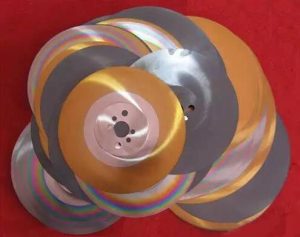1. Saw blade special-shaped crack
1. Characteristics and formation conditions of quenching cracks: often occur in unquenched saw blades or carburized parts, and the cracks are mostly located at the sharp corners of the saw blade and where the thickness is disparate.
2. Solutions and preventive measures:
The key is to reasonably formulate the heat treatment process parameters;
Improve the operator’s operating skills;
When designing, try to use arc transitions to avoid sharp corners.
2. Saw blade peeling crack
1. Crack characteristics and formation conditions: often appear in surface quenched parts or chemically heat treated parts. The peeling layer is the transition zone.
2. Solutions and preventive measures:
Temper immediately after quenching;
Reasonable selection of quenching heating parameters and cooling medium.
3. Longitudinal or transverse cracks
1. Crack characteristics and formation conditions: It often occurs in hardened saw blades, carbide bands in raw materials and serious tissue segregation, or non-inclusions extend longitudinally, crack inward from the surface, and the cracks are deep and long.
2. Solutions and preventive measures:
Eliminate carbide bands and segregation structures in raw materials, and strictly prohibit impurities exceeding the standard;
Reasonably formulate heat treatment process parameters;

4. Saw Blade Microcracks
The reasons for such cracks are more complicated.
1. Crack characteristics and formation conditions: often appear at the microstructure defects of acicular martensite, austenite grain boundaries and grain memory in high carbon steel.
2. Solutions and preventive measures:
Ensure that the chemical composition and organizational structure of the material are in a normal state;
The heat treatment process parameters should be strictly controlled;
Operators should continuously improve their skills, make up for some unforeseen factors, and avoid the occurrence of cracks.
5. Saw blade mesh cracks (also known as cracks)
1. Characteristics and formation conditions of quenching cracks: The surface is prone to such cracks after grinding. High hardness saw blades, chemical heat treatment parts, and high-frequency quenching parts also often produce such cracks. The cracks are on the surface of the saw blade with a depth of about 0.005~0.02mm.
2. Solutions and preventive measures:
The tempering after heat treatment should be sufficient;
When grinding, the feed amount should be small, and the heat generated during grinding should be minimized.



